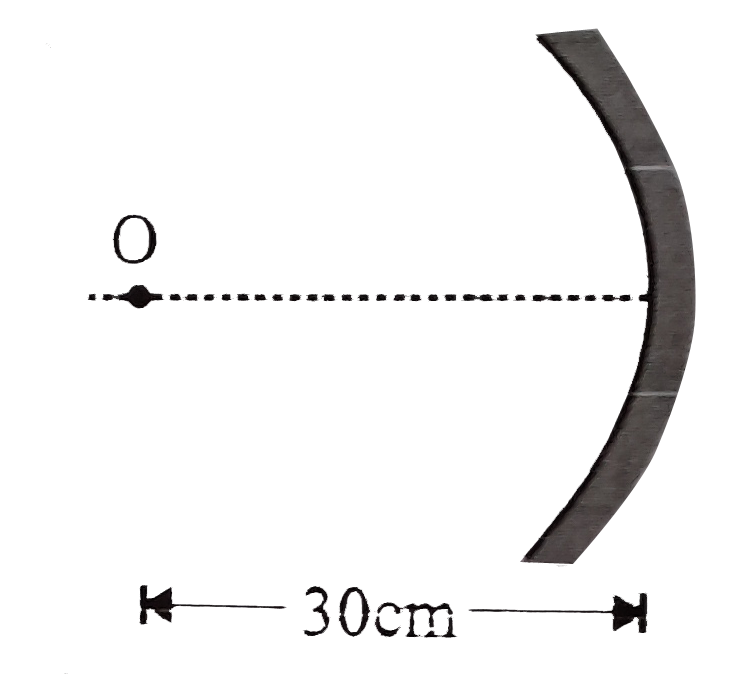An object is placed on the principal axis of a concave mirror at a distance of 1.5 f(f is the focal length). The image will be at,
1.5f
−1.5f
3f
−3f
The correct Answer is:D
To solve the problem of finding the image distance when an object is placed at a distance of 1.5f from a concave mirror, we will follow these steps:
1. Identify the Given Values:
- The object distance u=−1.5f (negative because the object is in front of the mirror).
- The focal length f of the concave mirror is also negative, so f=−f.
2. Use the Mirror Formula:
The mirror formula is given by:
1f=1u+1v
Here, we need to find the image distance v.
3. Substitute the Values into the Mirror Formula:
Substitute u and f into the mirror formula:
1−f=1−1.5f+1v
4. Rearranging the Equation:
Rearranging the equation gives:
1v=1−f+11.5f
5. Finding a Common Denominator:
The common denominator for the fractions on the right side is −1.5f:
1v=−1.5+1−1.5f
Simplifying the numerator:
1v=−0.5−1.5f
6. Simplifying Further:
This simplifies to:
1v=0.51.5f
Which can be simplified to:
1v=13f
7. Finding v:
Taking the reciprocal gives:
v=3f
Since we are dealing with a concave mirror, the image distance v will be negative:
v=−3f
Final Answer:
The image will be at a distance of −3f from the mirror.
- The object distance u=−1.5f (negative because the object is in front of the mirror).
- The focal length f of the concave mirror is also negative, so f=−f.
The mirror formula is given by:
1f=1u+1v
Here, we need to find the image distance v.
Substitute u and f into the mirror formula:
1−f=1−1.5f+1v
Rearranging the equation gives:
1v=1−f+11.5f
The common denominator for the fractions on the right side is −1.5f:
1v=−1.5+1−1.5f
Simplifying the numerator:
1v=−0.5−1.5f
This simplifies to:
1v=0.51.5f
Which can be simplified to:
1v=13f
Taking the reciprocal gives:
v=3f
Since we are dealing with a concave mirror, the image distance v will be negative:
v=−3f
The image will be at a distance of −3f from the mirror.
Topper's Solved these Questions
- RAY OPTICS AND OPTICAL INSTRUMENTS Book:PHYSICS WALLAHChapter:RAY OPTICS AND OPTICAL INSTRUMENTS Exercise:LEVEL - 2
Explore 30 Videos
- OSCILLATIONS Book:PHYSICS WALLAHChapter:OSCILLATIONS Exercise:NEET PAST 5 YEARS QUESTIONS
Explore 5 Videos
- SEMICONDUCTOR ELECTRONICS Book:PHYSICS WALLAHChapter:SEMICONDUCTOR ELECTRONICS Exercise:NEET PAST 5 YEAR QUESTION
Explore 23 Videos
Similar Questions
An object is placed on the principle axis of a concave mirror of focal length 10cm at a distance of 21cm from it. A glass slab is placed between the mirror and the object as shown in figure.
Find the distance of final image formed by the mirror.

View SolutionAn object is present on the principal axis of a concave mirror at a distance 30cmfrom it.Focal length of mirror is20cm

If object starts moving with 2cms−1 along principal axis towards the mirror then
View Solution
Knowledge Check
An object is placed on principal axis of concave mirror at distance of 1.5 f Image will be at
A-3fB1.5fC-1.5fD3fAn object of length 6 cm is placed on the principle axis of a concave mirror of focal length f at a distance of 4 f . The length of the image will be
A2 cmB12 cmC4 cmD1.2 cmAn object is present on the principal axis of a concave mirror at a distance 30cmfrom it.Focal length of mirror is20cm

If object starts moving with 2cms−1perpendicular to principal axis above the principal axis then,Aimage moves with velocity4cms−1below the principal axis.Bimage moves with velocity4cms−1above the principal axis.Cimage moves with velocity8cms−1below the principal axis.Dimage moves with velocity8cms−1above the principal axis.
An object is present on the principal axis of a concave mirror at a distance 30cm from it. Focal length of mirror is 20cm.

Q. Image formed by mirror is
View SolutionAn object is present on the principal axis of a concave mirror at a distance 30cmfrom it.Focal length of mirror is20cm

Image formed by mirror is
View SolutionAn object is present on the principal axis of a concave mirror at a distance 30cm from it. Focal length of mirror is 20cm.

Q. If object starts moving with 2cms−1 perpendicular to principal axis above the principal axis then,
View SolutionAn object is present on the principal axis of a concave mirror at a distance 30cm from it. Focal length of mirror is 20cm.

Q. If object starts moving with 2cms−1 along principal axis towards the mirror then,
View SolutionA point object is placed on the axis of the concave mirror at a distance of 60 cm from the focal point of the mirror. Its image is formed at the point of object then focal length of the mirror is
View Solution
